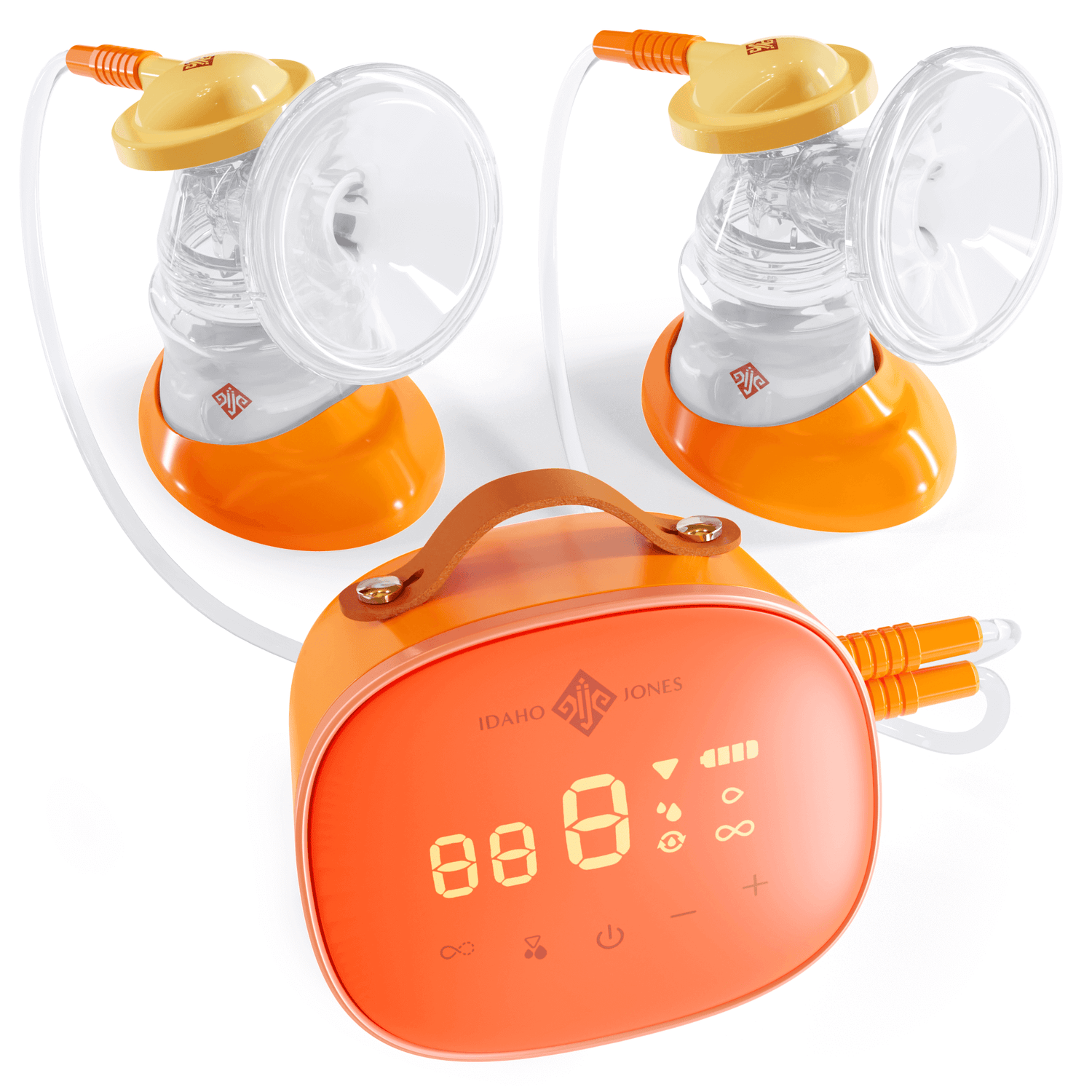
What Food Should a Mother Eat When Breastfeeding?
Share
Now that the baby has arrived, you may find yourself back at square one without a road map, wondering - what are the best foods for breastfeeding moms to eat? What foods should a breastfeeding mom avoid?
Breastfeeding mothers are concerned about what foods to eat for a number of reasons. They wonder what foods they need to eat in order to make nutritious milk for their babies. They wonder what foods will increase their milk supply (or even possibly decrease it, inadvertently). They wonder what foods might bother their baby, or make them gassy, fussy, or colicky. Still other new mothers wonder if they might need more calories to make a plentiful supply for their baby, or fewer calories in order to lose weight. And then, of course, mothers wonder when they will find time in the day to prepare a meal, let alone enjoy it.
The good news is there is no particular food a breastfeeding mother must eat or food plan a breastfeeding mom must follow in order to make nutritious milk for her baby. Your body will naturally prioritize milk production, taking all the nutrients it needs from you in order to provide rich, plentiful milk for the baby. Breastfeeding mothers need to eat nutrient dense foods that sustain them so that they have the well-being and energy to recover from childbirth and to care for their little ones. So while you can rest easy knowing that your milk is the perfect first food for your baby even if your own diet is not perfect, it is still important to keep yourself well nourished in order to feel your best and meet the demands of new motherhood.
It takes upwards of 250 calories per day to make milk for your baby, so if you’ve enjoyed a healthy pregnancy with typical weight gain, you may find you don’t need to do anything at all to lose your baby weight and that you shed it effortlessly over the early weeks and months post partum. In any case, losing baby weight should not be a priority in the early weeks and months of breastfeeding. Go easy on yourself. You’ve just given birth!
By the same token, most breastfeeding women who have enjoyed a healthy pregnancy don’t need to add calories to their diet to keep up. According to La Leche League, an internationally recognized mother-to-mother breastfeeding support organization, the best advice is to simply eat a wide variety of foods in as close to their natural state as possible.
What about spicy foods, or garlicky foods, or other foods you’ve heard may make your baby gassy or fussy? There certainly is anecdotal evidence on the topic. But, remember, milk isn’t made from the contents of your stomach; milk is synthesized from nutrients in your bloodstream. Since gas is caused when foods are broken down in the lower GI tract (large intestine), it’s unlikely that eating “gassy” foods like cabbage or broccoli or beans will cause gas in the baby. In most cases, breastmilk is easily and comfortably digested by the baby.
That said, it is possible that a baby could be sensitive to a particular protein that passes through the mother’s digestive tract into the bloodstream and then into the milk. Typical offending proteins are those found in cow’s milk and cow’s milk products, soy, wheat, and eggs. Mothers whose babies are unable to tolerate their milk may have to give up particular foods during the breastfeeding relationship. Some mothers will undergo an elimination diet in order to discover which foods are bothering the baby. If you suspect your baby may be sensitive to or intolerant of something in your diet, for example if your baby is showing skin rashes or eczema, signs of pain, or abnormal or foul smelling bowel movements, your pediatrician or your lactation consultant can help you determine the source of your baby’s discomfort and what to do about it.
What foods should a breastfeeding mother eat to increase her milk supply? While there are certain foods such as oatmeal and fenugreek teas and tinctures that are considered “lactogenic,” that is, they help a mother make more milk, remember that milk supply is primarily established and regulated by the baby’s suckling at the breast. The best way to establish and maintain a robust milk supply is by keeping your baby close and feeding on demand. Mothers who are separated from their babies after returning to work or for other reasons, or mothers whose babies are not effective nursers at the breast for any number of reasons, or mothers who prefer exclusive pumping, should increase pumping and try a few days or longer of “power pumping.” If you are concerned about your milk supply, lactogenic foods can give your supply a boost, but cannot substitute for the assistance and advice of a board certified lactation consultant.
So what to eat? Keep it simple. Allow friends and family to prepare meals for you, especially if they can be made in a batch and portioned out, with remainders going into the freezer for another day, like a lasagna, or tray of baked ziti, or other casserole type meals or stews. When the meal train stops, simple crock pot meals you can start early in the day are another great option. Many mothers find their baby is fussiest in the evening around dinner time. You will want to be prepared with a quick, easy meal ready to warm, plate up, and eat with one hand so you can hold the baby at the same time.
Why not try oatmeal for breakfast? Oats are long thought to be a lactogenic food. Cook your oats on the stovetop or make overnight oats in a jar (recipe follows). One-minute oats are fine, but the instant, just-add-water, processed oats are not known to help increase the milk supply. Top your oats with honey, a handful of nuts, butter, or any way you like. Or have a couple of hard-boiled eggs—they’re quick and easy, can be made in advance, and keep well in the fridge. And once they’re peeled, you can eat them with one hand while you’re holding the baby. For lunch, a delicious nut butter spread over banana slices, or sliced deli meat and cheese roll ups (yes, you can have deli meats again) are nutritious and easy for mothers trying to keep away from wheat and gluten.
A smoothie is another nice quick and nutritious option, and easy to prepare dairy free with oat milk, or coconut yogurt for creaminess. Throw in a tablespoon of nut butter to make it rich and filling. Or make it green with spinach or avocado. Flax seeds and brewers yeast are thought to be lactogenic, so by all means, add them to your smoothie, but beware the bitter aftertaste of brewer's yeast. Look for a brewer’s yeast that’s been “debittered.” Keep frozen berries on hand for smoothies, and try peeling your ripe (but not overripe) bananas and storing them in the freezer. Pop one into your morning smoothie or enjoy them on their own—they make a creamy, nutritious pick-me-up.
Overnight oats for nursing mothers: Mix 3 cups non dairy milk with 1/2c rolled oats plus 1/4c chia seeds, 1/4c hemp seeds, and 2tbsp flax meal. Let sit for 30 min, then stir in fruit (try blueberries!) and/or sweetener of your choice to taste. Enjoy! Makes 4 servings. Store in an airtight container in the fridge for up to 4 days.
Quick smoothie for breastfeeding mothers:
- 1 1/2 cups unsweetened non dairy milk (try oat milk)
- 1/2 cup frozen blueberries
- 1 frozen banana broken up into pieces.
- 1 tablespoon nut butter.
- ¼ cup rolled oats
- 2 tablespoons flax seeds or chia seeds
- A tablespoon of Brewer’s yeast (start with less, to make sure you can tolerate the taste).
Blend oats and chia or flax seeds in a high speed blender until well ground. Add the remaining ingredients and blend one to two minutes or until smooth, adding more milk as desired for a more liquid concoction. No need to add ice, the frozen blueberries and frozen banana will make it creamy and cold.
If you’d like to try something more adventurous, try experimenting with tahini. Sesame seeds are also thought to be a lactogenic food, just perfect for breastfeeding mothers and tahini is just sesame seed “butter.” Try using tahini in a smoothie instead of almond or peanut butter. Tahini tastes great with spices like cinnamon, cardamom, and vanilla extract, and a bit of honey will sweeten it nicely.
So if you find yourself wondering what foods are good for breastfeeding moms or what foods a breastfeeding mom should avoid, there’s no cause for worry. Your body will naturally make nutritious milk for your baby. Feed your baby on demand or pump frequently to make a robust milk supply. Keep meals simple, eat to appetite, accept help from friends and family, and prioritize getting rest when you can.
10 best foods for breastfeeding moms: Nursing moms can eat anything they want but the following are nutrient dense superfoods to keep in your rotation.
- Salmon and sardines: Rich in protein, B12, Vitamin D, and Omega 3s, which help with mood.
- Green leafy vegetables: Vitamins A and C plus calcium and iron. Low calorie so you can eat as much from this group as you like.
- Eggs: High in protein, B12 and folate. Eggs will not increase your cholesterol levels.
- Avocado: A rich, nutrient dense food, packed with vitamins (A, B, C, E, K), folate, and fiber.
- Beef: Zinc, iron, B vitamins. Choose grass fed to avoid antibiotics and hormones.
- Legumes (beans): Packed with protein, iron and fiber.
- Nuts, nut butter and seeds: Rich in protein, calcium, and antioxidants, but go easy. A handful of nuts is a serving size.
- Oatmeal: Long thought to be a lactogenic food. Rich in fiber and iron, too.
- Sweet potatoes: Vitamin A and potassium, easy, filling, and delicious.
- Apricots and dates: Lactogenic. Vitamins A and C, as well as potassium, fiber, and calcium. Choose fresh or dried for best quality and to avoid added sugars.


